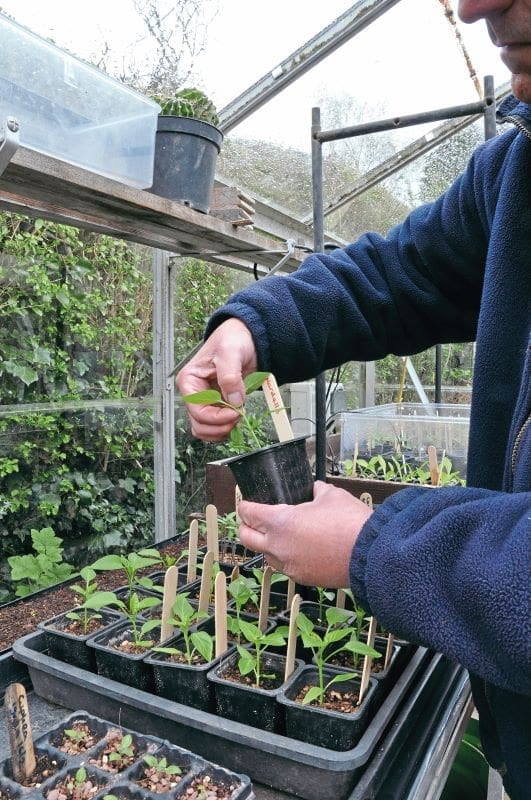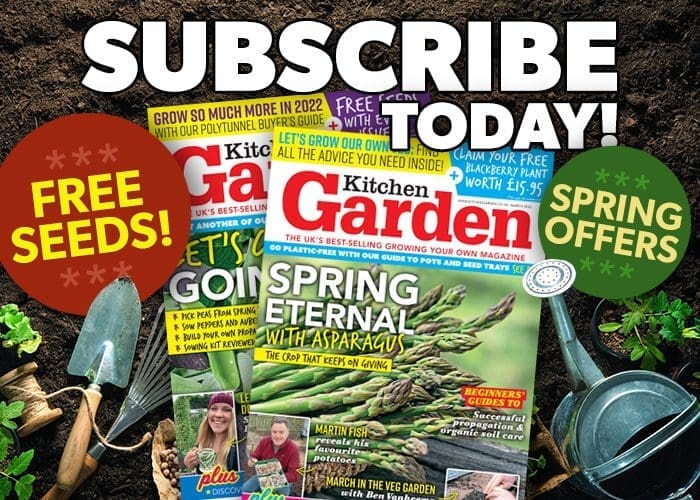Sometimes plants benefit from having their growing tips removed, as Becky Searle explains.
I slip on my gardening shoes and step out into the tepid morning air clutching a hot mug of coffee. I make my way directly to my greenhouse, where the sun pours in through the glass. The warm air greets me like a hug, and my shoulders relax. I start lifting propagator lids, letting the condensation flow into the corner and on to the floor. Little green shoots of life are boldly pushing through the soil or holding their leaves in upwards worship to the sun.
I move to my chillies and peppers, still cosy on their heat mats. They have several leaves now, some dark purple, others bright green. One has exquisite white variegation on the leaves. It’s a variety called ‘Fish’ that will go on to produce green and white striped fruit.
We are told so much conflicting information about gardening this time of year. Half the community seems to do one thing, half does something completely different, and everyone claims their way is best. The question of pinching out is no exception to this.
What is pinching out?
Pinching out, for those that don’t know, is the practice of beheading certain seedlings to encourage bushier growth. But, as with most things in the garden, there are those who do it and those who do not, especially when it comes to chillies and peppers.
I move in my greenhouse to the cosmos. They are around 10cm (4in) tall and some are already starting to produce a single bud in the centre atop the stem. Without hesitation, I take my thumbnail and forefinger and pinch the tops off. I know that in a few months, I will be regularly deadheading them, and each plant will produce innumerable pink and white flowers. The blooms will attract bees and hoverflies, and my garden will dance with hundreds of bobbing flower heads.
Many flowers can be pinched out in this way. Sweet peas are a good example. When these are about 10cm (4in) high you can nip the growing point out and they will produce more sideshoots. Antirrhinums also benefit from pinching out the tip. You can usually pinch most flowers out if they don’t produce a flower spike like a delphinium or a single stemmed sunflower. For most subjects it will cause them to branch and produce flowers on the sideshoots too.


Monocots and dicots
There are two distinct types of seed-producing plants, the monocotyledons and the dicotyledons. This time of year, you will notice that most of your seeds emerge with two seed leaves. These leaves are called cotyledons, and plants that produce them in pairs are called dicotyledonous. We call them the dicots for short. Some will emerge with just a single cotyledon; these are called monocots.
One interesting difference between the two is how they respond when you cut them. One of the most well-known monocots is grass. We cut our grass regularly in the summer, and it keeps coming back. Cutting it regularly encourages it to put more energy into root growth and generally creates healthier-looking, less patchy lawns. However, it never causes the grass to grow branches. This is because the growth site on grass and other monocots is at the base, where the roots meet the leaves. The growth site is where the main hormone that controls plant growth, a chemical called auxin, is stored. These growth sites are called meristems. If the growth site is at the bottom of the plant, such as with grass, it is called a basal meristem.
In dicots, the main growth site is at the top of the plant. This is called an apical meristem.
Auxin, the growth hormone, will tell the plant to grow upwards. This is called apical dominance. It ensures that the plant can reach the light and its optimum height for producing flowers or seeds. When the apical meristem is removed during pinching out, it removes the hormone that causes apical dominance. In doing so, the hormone balance inside the plant shifts towards the other meristems. They are located in the branches and are called lateral meristems. When this happens, the dominant growth becomes lateral. After a while, the apical meristems will regrow, and the plant will continue to grow upwards with plenty of branches. This is great news when we have flowering plants and want to get the best out of them.
Often in nature, the tops are taken off plants by grazers. It’s nature’s way of producing more flowers. The tops of flowering plants are often sweet and tender, particularly if you’re a bunny rabbit.
The problem that we get, however, when we start to pinch out plants such as chillies, peppers and aubergines is with balance. They are not usually grazed; chillies are spicy even in their leaves, and aubergines are covered in formidable spikes. While they respond brilliantly to being pinched by producing a lot of lateral growth, which can bear more fruit, they have lost their own natural ability to hold themselves up. This means that they will need support and quite a lot of it. Some plants, such as larger varieties of aubergine, are notorious for ripping themselves asunder rather than dropping their fruit. This can lead to the loss of quite a lot of fruits if we do not keep a watchful eye.

Every year, I hover over my chillies and peppers, trying to decide if I should pinch them out or not. Sometimes I do, sometimes I pinch just a few, and sometimes I don’t at all. The years that I do, I must provide more support, and I can’t say I am rewarded with noticeably more fruits.
In the years that I don’t, I sometimes have to provide support anyway.
I think a lot of gardening is trial and error. Finding your own way to do things. It can be quite overwhelming being bombarded with information, especially this time of year when we gardeners have enough to deal with! But plants want to grow. If we can think about how and why they grow and how things might occur in nature, we can sometimes tell the good information from the bad. But in gardening, we have the flexibility to make mistakes and to experiment and to guess. Plants are very forgiving. Go with what you feel is best, and if in doubt, try to learn more about how plants work, as it may just help you make better guesses!













